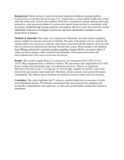| dc.contributor.author | Akoko, JM | |
| dc.contributor.author | MacLeod, E | |
| dc.contributor.author | Kang’ethe, E | |
| dc.contributor.author | Muinde, P | |
| dc.contributor.author | Alarcon, P | |
| dc.contributor.author | Muloi, D | |
| dc.contributor.author | Gachoya, J | |
| dc.contributor.author | Fevre, E | |
| dc.date.accessioned | 2016-12-09T08:45:15Z | |
| dc.date.available | 2016-12-09T08:45:15Z | |
| dc.date.issued | 2016-04 | |
| dc.identifier.citation | International Journal of Infectious Diseases Volume 45, Supplement 1, April 2016, Pages 464 | en_US |
| dc.identifier.uri | http://www.sciencedirect.com/science/article/pii/S1201971216309614 | |
| dc.identifier.uri | http://hdl.handle.net/11295/97950 | |
| dc.description.abstract | Background: Taenia solium is ranked as the most important foodborne parasite globally. Cysticercosis is caused by the larval stage of T. solium and is a serious public health risk in both rural and urban areas. Eastern and southern Africa have experienced a recent rapid growth in pig production, with increasing number of cysticercosis reports being received in concurrence with increasing smallholder pig keeping and pork consumption. However, there have been few studies undertaken in Kenya to investigate cysticercosis and more information is needed to assess transmission to humans.
Methods & Materials: This study was conducted in Ndumbuini, the main abattoir supplying pork to middle-low income consumers in Nairobi. The aims of the project were to: estimate the seroprevalence of cysticercosis; map the value chains associated with the abattoir; and assess the risk of cysticercosis-infected pork entering Nairobi food system. Blood samples were obtained from 700 pigs selected by systematic random sampling. Antigen ELISA was used to detect T. solium secretory antigen, while structured questionnaires, focus group discussions and observational tools were used to assess the risk factors.
Results: The overall seroprevalence of cysticercosis was estimated at 8.5% (95% CI: 6.4-10.7%). Pigs originated from 11 different counties. The prevalence rates ranged between 0-36%. Seven counties had seropositive pigs, four showed no positives. There was significant differences between sex (p = 1) or age (p = 0.13)of the pigs sampled. No positive cases were detected by post-mortem meat inspection. Therefore, all the carcasses were passed for human consumption. The abattoir had no facilities for treating Cysticerus solium infected carcasses.
Conclusion: This study highlights that T. solium is a public health risk to consumers of pork from Ndumbuini abattoir. We therefore recommend that meat inspection by palpation and incision be complemented with rapid tests. A wide scale general public sensitization should be undertaken. | en_US |
| dc.language.iso | en | en_US |
| dc.publisher | University of Nairobi | en_US |
| dc.title | Serological survey of porcine cysticercosis and associated risk factors in pigs slaughtered at Ndumbuini abattoir in Nairobi, Kenya | en_US |
| dc.type | Article | en_US |

